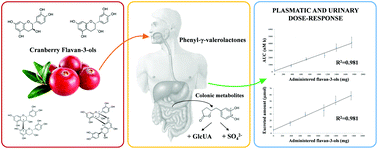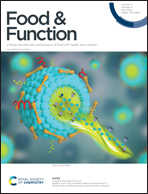Kinetic profile and urinary excretion of phenyl-γ-valerolactones upon consumption of cranberry: a dose–response relationship†
Abstract
Cranberries are a rich source of poly(phenols), mainly monomeric and oligomeric flavan-3-ols. However, information on the appearance of their main circulating microbial metabolites, namely phenyl-γ-valerolactones and phenylvaleric acid, is lacking despite its relevance to understanding the health effects attributed to cranberries. The aim of this study was to evaluate the absorption, metabolism and urinary excretion of cranberry flavan-3-ols through the targeted analysis of phenyl-γ-valerolactones and their related phenylvaleric acids, considering also their potential as biomarkers of flavan-3-ol intake and inter-individual variability in their appearance in plasma and urine. A six-arm acute crossover, randomized, double-blinded, controlled intervention trial was performed in ten healthy males who consumed a cranberry juice drink (375, 716, 1131, 1396, 1741 mg of total flavan-3-ols) or an isocaloric control drink with one-week washout. Plasma and urine were analyzed by UHPLC-ESI-QqQ-MS/MS and 22 compounds were identified. Glucuronide and sulfate conjugates of 5-(3′,4′-dihydroxyphenyl)-γ-valerolactone were the main circulating and excreted metabolites after cranberry juice intake, with glucuronidation appearing to be the most favorable conjugation route. These compounds reached maximum plasma concentration at about 4–6 h. Plasma and urinary concentrations of the sum of the metabolites increased in relation to the amounts of cranberry flavan-3-ols provided by the drink, showing a clear and linear dose-dependent relationship and underscoring their potential as biomarkers of flavan-3-ol intake. A high inter-individual variability in circulating and urinary metabolite levels was observed and, interestingly, some subjects seemed to display a greater efficiency in metabolizing flavan-3-ols and producing phenyl-γ-valerolactones.

- This article is part of the themed collections: Food & Function Recent HOT articles and International Conference on Polyphenols and Health (ICPH2019) collection


 Please wait while we load your content...
Please wait while we load your content...